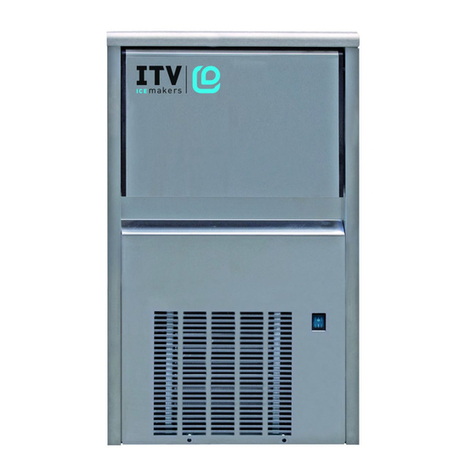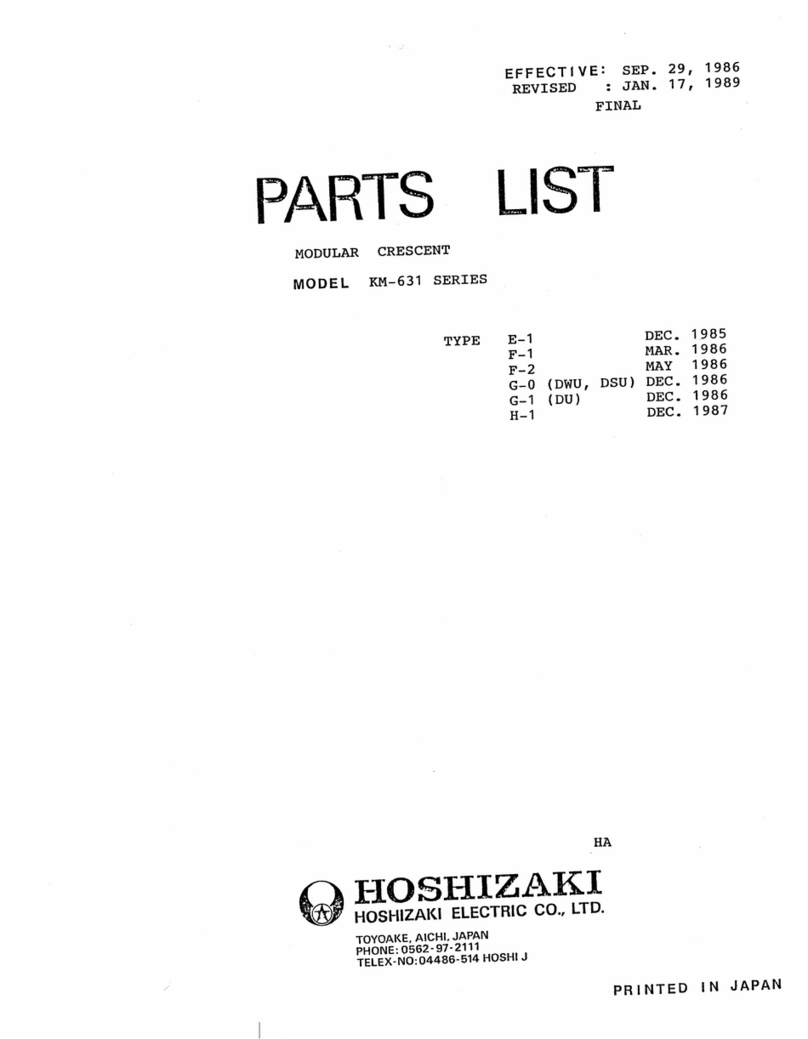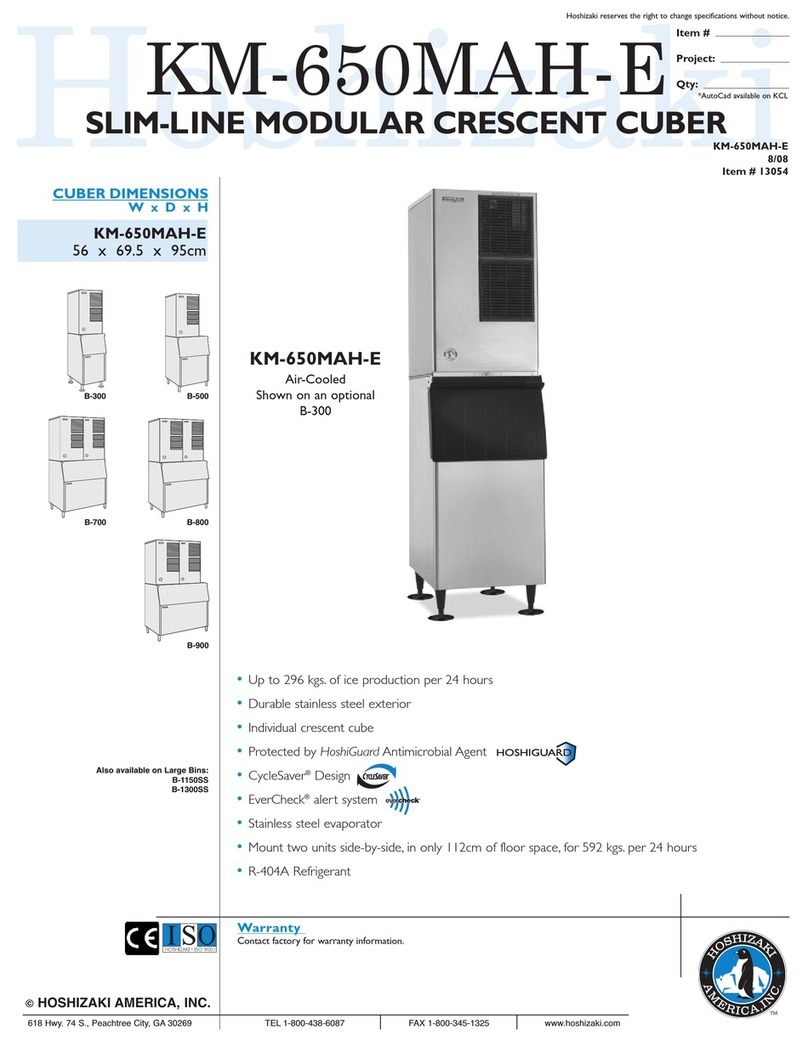BREMA Maidaid M155-65 Operating instructions

241635 rev. 00 •It is strictly forbidden to reproduce this instruction manual or any part thereof.
M22-5 to M155-65
User & Installation Instructions
automatic
ice-cube
maker

E
EN
N
Directive:
2014/35/EU
Low Voltage Directive
2006/42/CE
Machinery Directive
2014/30/EU
Electro agnetic Co patibility Direct
ive
2011/65/UE Restriction of the use of certain hazardous substances in electrical and electronic
equip ent
Standard:
EN 60335
-
1
Household and si ilar electrical appliances
-
Safety
-
Part 1: General require ents
EN 60335-2-75 Household and si ilar electrical appliances - Safety - Part 2-75: Particular
require ents for co ercial dispensing appliances and vending achines
EN 62233 Measure ent ethods for electro agnetic fields of household appliances and
si ilar apparatus with regard to hu an expos
ure
EN 12100 Safety of achinery - Basic concepts, general principles for design - Part 1: Basic
ter inology, ethodology
EN 55014-1 Electro agnetic co patibility: require ents for household appliances, electric tools
and si ilar apparatus. E ission
EN 55014-2 Electro agnetic co patibility: require ents for household appliances, electric tools
and si ilar apparatus. I unity
–
product
fa ily standard
EN 61000-3-2 Electro agnetic co patibility. Li its. Li its for har onic current e issions
(equip ent wit
h input current up to and including
16A per phase)
EN 61000-3-3 Electro agnetic co patibility. Li its. Li itation of voltage changes, voltage
fluctuations and flicker in public low-voltage supply
syste s, for equip ent with rated current ≤ 16A per phase and not subjected to
conditional connection
EN 50581 Technical docu entation for the assess ent of electrical and electronic products
with respect to the restriction of hazardous substances
Regulations and technical specifications:
D.M. 21/3/73 Regulations covering hygiene of packaging, recipients, tools and equip ent,
designed to co e into contact with foodstuffs and substances for personal use
CE 1935/2004
Materials and articles intended to co e into contact with food
CE 2023/2006 Good anufacturing practice for aterials and articles intended to co e into contact
with food
Original copy and
infor ation folder available at
Legal Representative of the Manufacturer / Authorized Representative
EC DECLARATION OF CONFORMITY
The above- entioned apparatus is designed for the production of ice. We the undersigned declare under our own
exclusive responsibility that the ice aker referred to in this declaration is in full co pliance with the require ents of the
following European Directives, standard, regulations, technical specifications and subsequent odifications.

Dear Custo er, Congratulations on having chosen a quality product which will certainly fully eet your expectations. Thank you for having
purchased one of our products. Please read this instruction manual carefully before usin your new auto atic ice-cube aker.
TABLE OF CONTENTS
1 IMPORTANT ADVICE AND RECOMMENDATIONS
2 TECHNICAL SPECIFICATIONS
3 ADVICE ABOUT TRANSPORTATION
4 UNPACKING
5 INSTALLATION
5.1 CONNECTION DIAGRAM
5.2 POSITIONING
5.2.a POSITIONING FOR FLUSH-MOUNTING MODELS
5.3 CONNECTION TO WATER MAINS
5.3.a WATER SUPPLY
5.3.b DRAIN
5.4 CONNECTION TO THE ELECTRICITY MAINS
6 START-UP
6.1 CLEANING INTERNAL PARTS
6.2 START-UP
6.2.a STARTING-UP MODELS WITH CONTINUOUS DELIVERY
6.3 CLEANING THE STEEL PARTS
7 MAIN CAUSES OF OPERATING FAILURE
8 OPERATION
8.1 MODEL WITH CONTINUOUS DELIVERY
8.1.a ADJUSTING DISPENSED QUANTITY
8.2 MODEL WITH COLD WATER DISPENSER
9 MAINTENANCE
9.1 CLEANING THE FILTER OF WATER SUPPLY SOLENOID VALVE
9.2 AIR-COOLED MODELS
9.3 CLEANING AND SANITIZING OPERATIONS
10 AUTOMATIC CLEANING (OPTIONAL FUNCTION)
11 AUTOMATIC SANITIZING (OPTIONAL FUNCTION)
11.1 NOTE FOR ICE MAKER WITH CONTINUOUS DELIVERY
11.2 NOTE FOR ICE MAKER WITH ABS FINISHING
11.3 NOTE FOR ICE MAKER WITH DAILY PRODUCTION OF 21 kg
11.4 NOTE FOR ICE MAKER WITH COLD WATER DISPENSER
11.5 NOTE FOR ICE MAKER WITH VERTICAL EVAPORATOR SYSTEM
12 ELECTRONIC TIMER (OPTIONAL FUNCTION)
12.1 START
12.2 OPERATION

E
EN
N
13 NOTES FOR CLEANING OF PRODUCT WITH ELECTRONIC TIMER (OPTIONAL FUNCTION)
13.1 CLEANING
13.2 SANITIZING
14 PERIODS AT A STANDSTILL
The figures in this manual are of a general nature. Some details may therefore differ depending on the specific model.
The Manufacturer declines all liability for any inaccuracies in this manual due to printing or transcription errors. The Manufacturer also
reserves the right to make any modifications to the products that may be necessary or useful, also in the interests of the user, without
impairing the products’ essential features of functionality and safety.
1 IMPORTANT ADVICE AND RECOMMENDATIONS
Before installin and usin the appliance, read the advice and
recommendations contained in this instruction manual very
carefully. They are iven in order to ensure safe installation, use
and maintenance of the appliance.
Before to start, ake sure that the appliance is intact. If in doubt, do
not use it and contact the authorized technical assistance center.
The ice aker can only be put into operation if the installation has
been carried out in co pliance with local laws and regulations and
according to the instructions in this anual.
It is absolutely forbidden for the user to access the appliance's
cooling circuit, in case of necessity, call the authorized assistance.
WARNING: Do not use echanical devices such as
screwdrivers, sharp tools or other eans to speed up the defrosting
process.
WARNING: Keep the vents in the appliance casing or flush-
ounting fra e clear fro obstructions.
WARNING: Do not da age the refrigerant circuit.

WARNING: Do not use electrical apparatus in the ice
co part ents
WARNING: Do not keep explosive substances in the apparatus
co part ent, such as aerosol spray cans with fla able propellant
In the event of da age to the refrigerant circuit: switch off the
achine i ediately, disconnect it fro the power supply, ventilate
the environ ent, call authorized service.
This instruction manual forms an inte ral part of the automatic
ice-cube maker (also more simply called “appliance” in the text)
and must be kept for possible future consultation.
The user ust keep this docu entation intact to allow it to be
consulted throughout the useful life of the appliance.
Keep this anual safe and ensure that it is available for consultation
near the appliance.
If lost or destroyed ask for another copy fro the distributor,
indicating the serial nu ber and odel of the appliance.
The anual describes the state of the art at the ti e of supply of the
appliance, the distributor reserves the right to odify its appliances
when dee ed useful at any ti e, without having to update this
docu ent or docu ent relating to previous production batches.
The technical staff in charge of the activities perfor ed on the
appliance are responsible for the application of the safety
require ents laid down in this anual, and shall ensure that the
authorised staff:
-are qualified to perfor the required activities
-know and co ply with the instructions laid down in this
docu ent

E
EN
N
-know and apply the national safety require ents applicable to
this appliance
In the event of the appliance being sold or transferred to another
person, this anual ust be handed over to the new user, in order to
enable hi to beco e fa iliar with the operation of the equip ent
and the corresponding advice and reco endations.
•No use fla es and source of ignition and co bustion
•always re ove the plug fro the power socket before proceeding
with any cleaning or aintenance operations
•to ensure the appliance operates efficiently and correctly, it is
essential to co ply with the Manufacturer’s instructions and to
ake sure that aintenance is perfor ed by specially qualified
personnel
•do not re ove any of the panels or grilles
•do not rest objects on the appliance or in front of the ventilation
grilles
•always lift the appliance to ove it, even slightly. Do not push or
pull it
•any use of the appliance other than for the production of ice using
cold drinking water is to be considered as i proper use
•do not obstruct the ventilation and heat-dissipation grilles, since
poor aeration - in addition to reducing efficiency and causing poor
operation - ay also cause serious da age to the appliance
•if the appliance breaks down and/or operates in a faulty way, switch
it off by eans of the ain switch fitted during the installation
phase, re ove the plug fro the socket (if any), and turn off the
water tap. Do not ake any atte pt to repair the appliance
yourself. Contact only professionally qualified and authorized
personnel

•in addition to rendering any for of warranty null and void,
odifying (or atte pting to odify) this appliance is extre ely
dangerous
•open and close the door carefully without sla ing it
•do not use the ice container to cool or preserve food or drinks, as
these operations could cause the drain syste to beco e clogged,
thus leading to the container filling up and water leaking out
•in the event of a failure, contact the dealer who sold you the
appliance; he will be able to give you the address of your nearest
Authorized Technical Service Centre. Always insist on having
original spare parts ounted
•any specific infor ation or diagra s regarding particular odels
will be attached to this anual
Use of this electrical appliance requires co pliance with certain
funda ental rules; in particular:
• do not touch the appliance with wet or da p hands or feet
• do not use the appliance when you are barefoot
• do not use extensions in pre ises such as bathroo s or shower
roo s
• do not tug on the power supply cable to disconnect it fro the ains
• this appliance can be used by children aged fro 8 years and above
and persons with reduced physical, sensory or ental capabilities or
lack of experience and knowledge, if they have been given
supervision or instruction concerning use of the appliance in a safe
way and understand the hazards involved. Children shall not play
with the appliance. Cleaning and user aintenance shall not be
ade by children without supervision
• supervise children to ensure that they do not play with the appliance

E
EN
N
Should you decide to scrap appliance, first disconnect the power
cable fro the ains, and then cut the cable off.
In addition, proceed as follows:
• break off and re ove the door in order to prevent the possible
danger of a child getting trapped inside
• do not allow the coolant gas and oil in the co pressor to disperse
into the environ ent
• dispose of or recover the various aterials according to the
provisions established by the current laws in force in your Country
This sy bol eans that this product should not be treated as a household waste. To prevent potential negative consequences for
the environ ent and health, be sure this product is correctly disposed of and recycled.
For infor ation on the disposal and recycling of this product, contact your Distributor or the Waste Treat ent Service.
This appliance does not contain coolant that dama es the
ozone layer. This appliance contains fluorinated reenhouse
ases covered by the Kyoto Protocol. This product is
hermetically sealed.
The Manufacturer shall not be liable for any dama e to the
environment, animals, persons or objects caused by incorrect
installation.
2 TECHNICAL DATA (Fi . 1)
The voltage and frequency are given on the data plate on the appliance. Refer to this data plate to check co pliance.
Voltage (1), power (2), odel (3), serial No. (4), Manufacturer (5).
The weighted equivalent continuous sound level A of this appliance is less than 70 dB(A). The easure ents were ade over an entire
production cycle, at a distance of 1 fro the surface of the appliance and at a height of 1.60 fro the floor.
The wiring diagra is stuck on the front counterpanel of the appliance.
In order to gain access thereto, unplug the appliance fro the power source, loosen screws holding the front panel, and slide it away after
first opening the door.
3 ADVICE ABOUT TRANSPORTATION
The net weight and the weight including packaging of the appliance are given on the cover of this anual. Please refer to the instructions
on the packaging in order to correctly transport and lift the appliance.
To prevent the oil in the co pressor fro flowing back into the coolant circuit, always ake sure that the appliance is kept upright during
transport, storage, and handling. Follow the instructions given on the packaging.
4 UNPACKING

The appliance must be installed by authorized personnel, in compliance with the current laws in force and the Manufacturer’s
instructions.
Once you have re oved the packaging according to the instructions on the box, MAKE SURE THAT THE APPLIANCE IS IN A
PERFECTLY GOOD CONDITION. IF IN DOUBT, DO NOT USE IT AND IMMEDIATELY CONTACT THE DEALER who sold it to you.
All the packa in items (plastic ba s, cardboard, polystyrene foam, nails, etc.) must be removed and put out of the reach of
children, as they are potential sources of dan er.
Rest the wooden pallet on the floor and, using a hex socket wrench, loosen and re ove the bolts (if any) that fix the appliance to the pallet
(Fig. 2).
Lift the appliance using equip ent fit to bear its weight. Separate the appliance fro the wooden pallet and fit the supplied legs into the
housings on the base plate provided for the purpose
(6 in Fig. 3).
Use a spirit level to ensure that the appliance is standing perfectly level. If necessary, adjust the legs.
5 INSTALLATION
5.1 CONNECTION DIAGRAM (Fi . 4)
7. electrical connection controlled by o nipolar circuit-breaker with residual current device
8. water tap
9. water supply pipe
10. water drainage pipe
5.2 POSITIONING
The appliance must be installed in a hy ienically clean location; it is advisable to avoid rooms like cellars and store-rooms,
because failure to meet hy iene requirements is likely to lead to the formation and proliferation of bacteria in the appliance.
The appliance can operate at an ambient temperature of between 10°C and 43°C.
The best performance will be obtained by installin the appliance in a place with an ambient temperature of between 10°C and
35°C and a water temperature of between 3°C and 25°C.
Avoid direct exposure to sunli ht and do not install near heat sources.
This appliance:
• must be installed in a place where it can be supervised by skilled personnel
• ust not be used outdoors
• ust not be installed in da p places or where it is liable to be sprayed with water
• ust not be cleaned with jets of water
• ust be allowed a clearance of least 5 c all around (this does not apply to the flush-mountin models)
5.2.a POSITIONING FOR FLUSH-MOUNTING MODELS
Ventilation is ensured by the grille on the front panel; it is therefore not necessary to leave any gap, except to facilitate installation.
A hole ust be ade in the surface where the appliance is to be located so that the power cable, water supply pipe and the water drain
pipe can be passed through as shown in Fig. 5.
The plug and water supply and drain connections are accessible fro the front panel.
To access these, disconnect the appliance fro the power supply, unscrew the screws that hold the front panel in place and after
opening the door, pull out the panel fro above (Fig. 6).
Before fitting the appliance in place, the power cable ust be fixed to the base plate as shown in the diagra in Fig. 6:
• pass the plug and cable (11) through the hole (12) in the plate
• position the cable cla p (13) in its housing
Fit the front panel back in place after aking these connections.
5.3 CONNECTION TO THE WATER MAINS
IMPORTANT:
•the appliance ust be connected to the water ains by professionally qualified personnel in accordance with the Manufacturer’s
instructions
•this appliance ust be only be supplied with cold water for hu an consu ption (drinking water)
•the operating pressure ust be between 0.1 and 0.6 MPa

E
EN
N
•a tap ust be installed between the water ains and the feed pipe of the appliance, so that the water supply ay be shut off if
necessary
•where the feed water is particularly hard, you are advised to install a polyvalent cartridge filter. Any solid particles (e.g. sand) ay be
eli inated by installing a echanical filter, which ust be periodically inspected and cleaned. These devices ust co ply with the
standards in force in the Country of use
•Is forbidden install the machine to De-ionized or Reverse Osmosis Water
•never turn the water supply tap off when the appliance is working
•only new hose-sets supplied with the appliance are to be used to connect the appliance to water ains, old hose-sets should not be
reused
5.3.a FILLING WITH WATER (Fi . 7)
Insert the special seals provided (15) in the two threaded ring nuts (14) of the water supply pipe (9) supplied with the appliance.
Without exerting excessive force (otherwise the unions could crack), fir ly tighten one of the threaded ring nuts on the outlet of the
solenoid valve located in the rear of the appliance (front for the flush-mountin models). The other threaded ring nut ust be
screwed to the water tap (8); this too ust be provided with a thread.
5.3.b DRAIN (Fi . 7)
Fix the water drain pipe (10) in the housing provided on the rear of the appliance (front for the flush-mountin models). Make sure
that:
• the pipe is a hose
• the internal dia eter is 22 , as required
• the water drain hose is not throttled at any point throughout its length
• the drain hose slopes downwards by at least 15%
It is advisable to drain the water straight into an open drain trap.
5.4 CONNECTION TO THE ELECTRICITY MAINS
IMPORTANT:
•the appliance ust be connected to the electricity ains by professionally qualified personnel in accordance with the Manufacturer’s
instructions
•before connecting the appliance to the electricity ains, ake sure that the ains voltage rating corresponds to the value indicated on
the rating plate
•ake sure that the appliance is connected to an efficient earthing syste
•ake sure that the capacity of the power supply syste suits the axi u power value indicated on the rating plate of the appliance
•if the appliance co es supplied with a plug, prepare a socket controlled by an o nipolar circuit-breaker (7 in Fig. 4), with a contact-
opening gap of not less than 3 , that provides full disconnection under overvoltage category III conditions, in accordance with
national safety standards currently in force. This switch ust be equipped with fuses, with the associated residual current device
positioned in such a way as to be readily accessible. Insert the plug into the socket controlled by the switch (7 in Fig. 4)
•the plug ust only be replaced by professionally qualified and authorized personnel, and the new plug ust co ply with current
national safety standards
•if the appliance co es supplied without a plug and you wish to connect it per anently to the power supply, prepare an o nipolar
circuit-breaker (7 in Fig. 4), with a contact-opening gap of not less than 3 , that provides full disconnection under overvoltage
category III conditions, in accordance with national safety standards currently in force. This switch ust be equipped with fuses, with
the associated residual current device positioned in such a way as to be readily accessible. This operation must be carried out by a
specialized technician
•ake sure that you fully uncoil the power supply cable and check that it is not crushed in any way
•should the supply cable be da aged, it ust be replaced by a specialized technician using a special cable available fro the
Manufacturer or fro the Technical Service Centres
6 START-UP
6.1 CLEANING INTERNAL PARTS
The appliance will have already been cleaned in the factory. However, you are advised to wash the internal parts again before using the
appliance. Make sure that the power supply cable is unplugged before carrying out the above cleaning operation.
See cleanin and sanitizin manual for information re ardin cleanin operations.
For cleaning operations in general, use an ordinary detergent for washing dishes or a solution of water and vinegar. Rinse thoroughly with
plenty of cold water and re ove any ice that ay have been produced during the first 5 cycles after cleaning, together with any ice present
in the bin.
It is advisable to avoid using abrasive detergents or powders, since these ight da age the finish.

6.2 START-UP
When you start up the appliance the first time, or when you start it up a ain after a lon period at a standstill, fill the basin
manually with water (Fi . 8).
This filling operation ust be carried out by opening the door, raising the flaps (if any) and pouring the water directly into the internal basin.
In the cycles subsequent to the initial one, the appliance will be filled with water in a fully auto atic way.
Once the appliance has been correctly connected to the electricity ains, water ains and water drain syste , it can be started up as
follows:
a) turn on the water supply tap (8 in Fig. 4)
b) insert the plug (if any) in the socket and switch on the power supply by eans of the relative switch fitted during the installation phase
(7 in Fig. 4)
Switch on appliance by pressing the lu inous switch (16 in Fig. 3).
For appliances that are connected per anently to the electricity ains, turn on by eans of the switch on the outside of the appliance,
fitted during the installation phase.
6.2.a STARTING UP MODELS WITH CONTINUOUS DELIVERY (Fi . 9)
Carry out operations a) and b) described above; then:
• re ove the plug (17) on the front grille panel
• using a screwdriver turn the adjusting screw of the ti er clockwise until you hear a click and the water pu p stops
• repeat the previous operation three ti es consecutively at intervals of one inute each
• when this operation has ter inated, fit the plug (17) back on the front grille; the appliance will auto atically start producing ice
6.3 CLEANING THE STEEL PARTS
The appliance was cleaned initially in the factory. For subsequent cleaning operations on the steel parts of the achine, co ply with the
instructions below:
Do not allow saline solutions to dry or pool on the external steel co ponents of the achine, as this ay lead to corrosion.
Avoid contact with ferrous aterial (scourers, forks, ladles, scrapers, etc.) to prevent corrosion, conta ination fro ferrous particles
circulating in the receptacle.
Carefully clean the stainless steel parts with a da p cloth, water and soap or co on, non-abrasive chlorine or a onia based
detergents.
7 MAIN CAUSES OF OPERATING FAILURE
Should the appliance fail to produce ice, before calling on the Authorized Technical Service Centre, first check carefully that:
• the water supply tap (8 in Fig. 4), fitted during the installation phase, has been turned on
• electric power is reaching the appliance; the plug (if any) is properly inserted in the socket, the switch (7 in Fig. 4) is in the “ON” position,
and the push button (16 in Fig. 3) is lighted up
Further ore:
• if there is excessive noise, ake sure that the appliance is not touching furniture or sheet etal which can give rise to noise or vibrations
• should any trace of water appear, check the drain hole of the container to ensure that it is not clogged, that the water fill and drain pipes
are correctly connected and are not throttled or da aged
• ake sure that the te perature of the air or water does not exceed the installation li it values (see paragraph 5.2)
• ake sure that the water inlet filter is not clogged (see paragraph 9.1)
• ake sure that the spray nozzles are not clogged with scaly deposits
If the fault still persists after the above inspections have been ade, turn off the electric power source by eans of the switch fitted during
the installation phase, pull out the plug fro its socket, turn off the tap connecting the appliance to the water ains, and contact the
nearest Authorized Technical Service Centre.
To obtain a faster and ore efficient reply when you call the Centre, state the odel of the appliance precisely, together with its serial
nu ber or anufacturing nu ber. This infor ation is given on the serial N° plate (Fig. 1) affixed to the rear of the appliance and on the
cover of this anual.
8 OPERATION
The appliance has a ther ostat probe in the ice bin, which stops ice production when the ice accu ulated in the bin reaches the probe
connected to the ther ostat.
When ice is taken fro the bin, the ther ostat will auto atically reactivate ice production, thus creating a new supply of ice.
8.1 MODEL WITH CONTINUOUS DELIVERY (Fi . 10)

E
EN
N
The appliance is equipped with an ice-cube dispenser (18) on the front.
To take the required quantity of ice, place a glass or a suitable container under the dispenser and press the button (19) to turn on the
supply.
8.1.a ADJUSTING DISPENSED QUANTITY (Fi . 11)
IMPORTANT:
• the operations described below ust be perfor ed by a specialized technician, and only after disconnecting the appliance fro the
electricity ains
• all operations that require handling of parts ade of etal plate ust be carried out wearing suitable gloves to prevent cuts
The appliance is provided with an electronic device for adjusting the quantity of ice dispensed each ti e.
To increase or decrease the dispensing ti e and the proportionate quantity of ice dispensed, proceed as follows:
• re ove the basin (20)
• slacken off the screws (21) on the front panel using a Phillips screwdriver
• pull out the front panel fro above
• turn the knob (22) on the electronic device clockwise to increase the quantity of ice dispensed whenever the button is pressed, and
anti-clockwise to reduce the quantity
8.2 MODEL WITH COLD WATER DISPENSER (Fi . 12)
The appliance is provided with a cold water dispenser located beside the ice bin.
To obtain cold water, place a glass under the outlet and gently press the button (23) to turn on the water tap. Release the button to stop
the flow of cold water.
If the appliance is already provided with a filter located on the cold water supply circuit, read the instructions on the filter label carefully and
follow the anufacturer’s reco endations regarding the replace ent schedules.
9 MAINTENANCE
9.1 CLEANING THE FILTER OF WATER SUPPLY SOLENOID VALVE (Fi . 13)
All the operations described in this para raph must be carried out only after the electric power and water supplies have
been disconnected, as described previously, by professionally qualified and authorized personnel.
At least every two onths, clean the filter (24) located on the water inlet solenoid valve, proceeding as follows:
• switch off the electric power supply by eans of the switch (7 in Fig. 4), fitted during installation, and disconnect the plug of the
appliance fro its socket (if any)
• shut off the water supply by turning the tap (8 in Fig. 4) fitted during installation
• unscrew the threaded ring nut (14) of the water feed hose, located at the outlet of the solenoid valve at the rear of the appliance (front
for the flush-mountin models). For the built-in odel, first re ove the panel as indicated at point 5.2.a
• using a pair of pliers, re ove the filter (24) fro its seat without da aging the water feed pipe connector
• place the filter under a strong jet of water to re ove residue, but replace the filter if it is excessively dirty
After having carried out the cleaning operations, refit the filter and hose pipe taking the necessary precautions described earlier in the
anual.
When the operations have terminated, turn on both the electricity supply and water supply.
9.2 AIR-COOLED MODELS (Fi . 14)
For air-cooled odels, it is very i portant to keep the finned condenser and its external filter
(if any) clean.
Have the finned condenser cleaned at least once every two onths by an Authorized Technical Service Centre, which can include this
operation in the scheduled aintenance progra e.
The external filter (if any) ust be cleaned at least once a onth, as follows:
• switch off appliance and cut off power supply with the switch (7 in Fig. 4) fitted at the installation stage
• open plastic grille
• re ove filter and keep it at a distance for the appliance
• re ove dust fro filter by blowing with co pressed air
• replace filter in its seat and close plastic grille
9.3 CLEANING AND SANITIZING OPERATIONS
A cleanin and sanitizin kit specifically desi ned for this appliance is available from your dealer.

Do not use corrosive substances to remove limescale from the appliance, because this will invalidate the warranty, and may
cause serious dama e to the materials and components of the appliance.
Do not use jets of water to clean the appliance.
All cleanin operations must be carried out only after the electric power and water supplies have been disconnected, as
described previously, by professionally qualified and authorized personnel.
Follow the instructions iven in the cleanin and sanitizin manual supplied with the appliance.
IMPORTANT:
All the ice produced durin the first 5 cycles after cleanin and sanitizin operations, and any ice already in the container, must
be eliminated.
Co plete sanitizing can only be carried out only by the Authorized Technical Service Centres, and ust be done regularly depending on
the conditions of use of the appliance, the che ical and physical features of the water, and after every period in which the appliance has
re ained at a standstill for any length of ti e.
You are advised to ask your dealer to draw up a scheduled aintenance contract that will cover the following:
• cleaning the condenser
• cleaning the filter located on the water supply solenoid valve
• cleaning the ice container
• checking the charge of coolant gas
• checking the operating cycle
• sanitizing the appliance
10 AUTOMATIC CLEANING (OPTIONAL FUNCTION)
The frequency of cleaning and sanitizing operations can vary, depending on:
• te perature and environ ental conditions
• te perature and quality of water (hardness, presence of grit, etc.)
• quantity of ice produced, or ti e of use of ice-cube aker
• periods of non-use of ice-cube aker
TO ENSURE CORRECT CLEANING AND SANITIZING OF THE ICE-CUBE MAKER, PERFORM THE OPERATIONS DESCRIBED IN
THIS MANUAL AT LEAST ONCE A MONTH.
IMPORTANT:
• the operations described in this anual ust only be perfor ed by skilled, authorised personnel
• the appliance ust be installed in a hygienically clean location; avoid pre ises such as cellars and storeroo s, because poor hygiene
pro otes the for ation and proliferation of bacteria in the ice-cube aker
• a cleaning and sanitizing kit specifically designed for this appliance is available fro your dealer
• do not use corrosive substances to re ove li estone fro the appliance, because this will invalidate the guarantee, and ay cause
serious da age to the aterials and co ponents of the appliance
• gloves suitable to protect against cuts ust be worn when perfor ing all operations involving handling of sheet etal parts in particular
• Gloves suitable to protect the skin against the substances used ust be worn when perfor ing all cleaning and sanitizing operations
• wear suitable goggles during cleaning and sanitizing operations to protect the eyes against splashes of the substances used
• take care not to spill water or solutions on the wiring or the power cable
1. wait for ice cubes to drop, switch off appliance, disconnect fro the electricity ains supply and open door
2. re ove all ice fro container
3. re ove flag support asse bly (1 in Fig. 15) and ice-cube slide (2 in Fig 2. 15) and extract overflow pipe (3 in Fig 2. 15) to drain water
present in basin
4. reposition overflow pipe and fill basin with a 25% solution of water and white vinegar. Refer to the table for the a ount of solution
required, depending on daily output (Fig. 16)
5. reposition ice-cube slide and flag support asse bly
6. close door and operate appliance for five one- inute periods, with a five- inute interval between each
IMPORTANT: The pump must be in operation durin cleanin cycles (check that water is sprayed). If it is not, immediately
adjust the timer re ulation screw by turnin it clockwise until the indicator on the pin exits from the zone marked DEFROST.
To reach ti er, loosen screws in front panel with a Phillips screwdriver, re ove front panel by pulling it upwards, and regulate ti er with a
flat-head screwdriver (Fig. 17).
7. switch off achine and disconnect it fro electricity ains and water supply

E
EN
N
8. re ove top of appliance by lifting rear part and releasing it fro front hooks (Fig. 18). NOTE: on so e odels the top is secured to
the rear panel of the appliance with a screw, which ust be re oved before lifting the top and repositioned when cleaning and
sanitizing operations are finished
9. re ove evaporator cover panel (Fig. 19) and clean top part of evaporator, bin, evaporator cover panel and door with water and
vinegar solution
10. re ove any sedi ent fro evaporator and evaporator cover panel using a brush with soft bristles and a non-abrasive sponge
11. pour plenty of cold water onto the evaporator and with the aid of the brush, direct the sedi ent re oved into the basin beneath, taking
care not to obstruct the holes in the base of the evaporator.
During cleaning of evaporator, take care:
• not to bend coils
• not to detach water supply pipes
• not to re ove evaporator ther ostat
12. re ove (Fig. 15) and clean with ordinary washing-up liquid:
• flag support asse bly (1)
• ice-cube slide (2)
• overflow pipe (3)
• sprayer bank (4), taking care to re ove side caps (5)
• sprayer bank feed pipe (6)
• pu p filter (7)
13. clean with the sa e washing-up liquid:
• evaporator cover panel
• inner basin
• bin
• door
14. thoroughly rinse previously cleaned parts with cold water
15. rinse and refit (Fig. 15):
• pu p filter (7)
• sprayer bank feed pipe (6)
• sprayer bank (4), after repositioning side caps (5)
• overflow pipe (3)
• evaporator cover panel (Fig. 5)
16. prepare to perfor the sanitizing operations described in the next chapter
11 SANITIZING
Use a 200 g/l solution of sodiu hypochlorite and water (or a solution of ½ ounce of nor al bleach to 1 gallon of water) or one of the
solutions co only used to disinfect babies’ feeding bottles; in this case, check that the sanitizing product is:
• authorized by your country’s Ministry of Health
• suitable for use with food achines
• not har ful to the aterials and co ponents of this appliance
For the directions for use and concentrations, please refer to those shown on the packaging and reco ended by the anufacturer. We
reco end using the solution at the te perature of 25°C.
1. fill basin with sanitizing solution. Refer to the table for the a ount of solution required, depending on daily production (Fig. 2)
2. refit ice-cube slide (2 in Fig. 1) and flag support asse bly (1 in Fig. 15)
Before connectin the appliance to the mains electricity supply, ensure that all cables and electrical wirin are perfectly
dry.
3. operate ice aker for five one- inute periods, with a five- inute break between the
IMPORTANT: The pump must be in operation durin sanitizin cycles (check that water is sprayed). If it is not, immediately
adjust timer re ulation screw by turnin it clockwise until the indicator on the pin exits from the zone marked DEFROST.
To reach ti er, loosen screws in front panel with a Phillips screwdriver, re ove front panel by pulling it upwards, and regulate ti er with a
flat-head screwdriver (Fig. 17).
4. switch off achine and disconnect it fro the ains electricity and water supply
5. re ove evaporator cover panel (Fig. 19)
6. pour sanitizing solution onto top part of evaporator, distribute with a brush, and rinse thoroughly with cold water
7. re ove (Fig. 1) and i erse in sanitizing solution for 30 inutes:
• flag support asse bly (1)
• ice-cube slide (2)
• overflow pipe (3)
• sprayer bank (4) and side caps (5), after re oving the fro the bank
• sprayer bank feed pipe (6)
• pu p filter (7)
• evaporator cover panel (Fig. 19)
8. wipe container walls and door with sanitizing solution using a sponge and brush

9. drain sanitizing solution re aining in pu p body by introducing pressurised water into the suction pipe and checking that the water
exits fro the delivery pipe (Fig. 20)
10. thoroughly rinse inner basin, door and container with cold water
11. thoroughly rinse ice-cube slide, evaporator cover panel, sprayer bank and the corresponding side caps, flag support asse bly,
overflow pipe, pu p filter and sprayer bank feed pipe under running water
12. refit parts previously re oved
13. reposition top, securing it to rear panel with the screw, if present
The ice-cube aker can now be reactivated as specified in the instruction anual.
IMPORTANT: All the ice produced durin the first five cycles after cleanin and sanitizin operations must be discarded.
THE FOLLOWING ADDITIONAL OPERATIONS ARE REQUIRED FOR SOME SPECIAL MODELS:
11.1 NOTE FOR ICE MAKER WITH CONTINUOUS DELIVERY
To access the inner parts, re ove top of appliance (Fig. 18), then re ove front upper panel as shown in Fig. 21.
In addition to the operations described in chapters 10 and 11, the following steps ust be taken when cleaning and sanitizing the ice
collecting bin (Fig. 21):
1. tilt appliance towards the front by positioning a shi at least 4 c thick under the back legs
2. position a basin under the ice-cube dispenser pipe (8)
3. raise outlet pipe until it is higher than the appliance
4. pour water and vinegar solution onto ice-cube conveyor screw until solution exits fro ice-cube dispenser pipe (8)
5. leave solution in bin for at least 30 inutes, then drain solution and return outlet pipe to its original position
6. wipe ice-cube collection bin walls and conveyor screw with a water and vinegar solution using a sponge and brush; avoid rotations
which could da age the drive otor
7. repeat operations 3 to 6 using the sanitizing solution
8. thoroughly rinse walls of ice collection bin with cold water
9. rinse ice-cube conveyor screw and botto of bin with cold water, allowing it to flow along the ice dispenser pipe (8)
10. drain water re aining on botto of bin and return outlet pipe to its original position
11.2 NOTE FOR ICE MAKER WITH ABS FINISHING (Fi . 23)
To access inner basin, evaporator and ti er regulation screw:
• re ove screw cover
• re ove screws with a Phillips screwdriver
• open front door and re ove ABS shell
11.3 NOTE FOR ICE MAKER WITH DAILY PRODUCTION OF 21 k
Perfor cleaning and sanitizing operations as described in chapters 10 and 11.
To reach pu p filter (Fig. 24):
• re ove flag support asse bly (1) and ice-cube slide (2) and extract overflow pipe (3) to drain water present in the basin
• disconnect pu p connection pipes (10) and sprayer bank (11)
• unscrew the filter threaded ring nut (9)
To access pu p side of inner basin:
• re ove rear panel by loosening fixing screws and extracting it upwards (Fig. 25)
• re ove pu p connector pipe (10 in Fig. 24)
• release pu p wiring (12 in Fig. 26) and re ove pu p asse bly located on right-hand side of evaporator by lifting it out of its seating,
taking care not to da age the wiring (Fig. 26)
• wipe pu p container walls with a water and vinegar solution and sanitizing solution using a sponge; take care not to wet the electrical
parts
• at the end of cleaning and sanitizing operations on the basin, refit pu p, taking care to connect sprayer bank connector pipe (10 in Fig.
24) and pu p connector pipe (11 in Fig. 24) correctly and to re-secure pu p wiring
(12 in Fig. 26)
11.4 NOTE FOR ICE MAKER WITH COLD WATER DISPENSER
Perfor cleaning and sanitizing operations as described in chapters 10 and 11, also re oving the following co ponents for cleaning and
sanitizing operations (Fig. 27):
• water cooling coil (13)
• coil cover grille (14)
Thoroughly rinse inside of cooling coil by circulating pressurised cold water through it.
Clean and sanitize cold-water dispenser area.
To access ti er regulation screw in odels with a 21 kg/24h output (Fig. 28):
• re ove screw connecting top to rear panel
• raise rear part of top and release it fro front hooks
• regulate ti er with a flat-head screwdriver

E
EN
N
To access pu p filter and pu p side of inner basin, see chapter 6.
11.5 NOTE FOR ICE MAKER WITH VERTICAL EVAPORATOR SYSTEM
Perfor cleaning and sanitizing operations as described in chapters 10 and 11, in accordance with the following instructions:
• to re ove evaporator cover (15) and ice-cube slide (2) and extract overflow pipe (3), see Fig. 29
• to re ove sprayer bank (4) and the corresponding side caps (5), see Fig. 30
• to clean and sanitize pu p filter (7), see Fig. 30
• clean front and back of evaporator using a brush with soft bristles
• clean and sanitize tilting panel (16) shown in Fig. 30
12 ELECTRONIC TIMER (OPTIONAL FUNCTION)
12.1 START
Once the appliance has been correctly connected to the electricity ains, water ains and water drain syste , it can be started up as
follows:
a) turn on the water supply tap (8 in Fig. 4)
b) insert the plug (if any) in the socket and switch on the power supply by eans of the relative switch fitted during the installation phase
(7 in Fig. 4)
Switch on appliance by pressing the lu inous switch (1).
For appliances that are connected per anently to the electricity ains, turn on by eans of the switch on the outside of the appliance,
fitted during the installation phase.

12.2 OPERATION
The appliance has a ther ostat probe in the ice bin, which stops ice production when the ice accu ulated in the bin reaches the probe
connected to the ther ostat.
When ice is taken fro the bin, the ther ostat will auto atically reactivate ice production, thus creating a new supply of ice.
FUNCTIONS
D
W
DEFR.
WASH
ON/OFF PUSH BUTTON: used to turn on and turn off the appliance - GREEN LED
DEFR. PUSH BUTTON: allows to start the defrost cycle - YELLOW LED
WASH PUSH BUTTON: allows to start and/or finish the washing cycle - BLUE LED.
FUNCTIONS
Pressing the ON/OFF push button, at the appliance’s start-up, the green LED start to flash for 3 inutes,
during this ti e the water is charged in the appliance’s basin.
After the 3 inutes have elapsed, the appliance starts a defrost cycle: green LED and yellow LED are lit.
Once the defrost is over, the appliance starts the ice production: green LED is lit.
It is possible to start at any ti e the defrost cycle pressing the DEFR. push button, the yellow LED is lit.
This operation ust be perfor ed by professional and qualified technical person.
Pressing the WASH push button, the appliance starts the washing cycle: the blue LED starts to flash.
ATTENTION:
To Push “W” (washin ) use only a plastic tool with rounded toe applyin a sli ht pressure. (fi . 3).
Please not use a screw or similar tools.
The washing cycle is ade by the following phases:
•defrost (yellow LED lit + green LED lit + blue LED flashing)
•30 inutes when only the water pu p is operating (green LED lit + blue LED flashing);
•60 inutes when the water inlet valve and water pu p are operating (green LED lit + blue LED flashing)
GREEN LED
YELLOW
LED
BLU
E LED
ON/OFF PUSH
BUTTON
DEFR. PUSH
BUTTON
WASH PUSH
BUTTON
D
W
DEFR.
D
W
WASH

E
EN
N
Once the washing cycle is over, the appliance resu es its operation at the sa e point it was when the WASH
push button was pressed.
It is possible to exit at any ti e the washing cycle by pressing the WASH or the DEFR. push button.
13 NOTES FOR CLEANING OF PRODUCT WITH ELECTRONIC TIMER (OPTIONAL FUNCTION)
To carry out the cleaning and the sanitizing operations, follow the directions below:
13.1 CLEANING
1. wait for ice cubes to drop and re ove all ice fro container
2. re ove flag support asse bly (1 in Fig. 15) and ice-cube slide (2 in Fig 2. 15) and extract overflow pipe (3 in Fig. 15) to drain water
present in basin
3. reposition overflow pipe and fill basin with a 25% solution of water and white vinegar. Refer to the table for the a ount of solution
required, depending on daily output (Fig. 16)
4. reposition ice-cube slide and flag support asse bly
5. with plastic tool, push the “W” button (wash position) through dedicated hole below “ON/OFF” button. (Fig 17)
The blue LED starts to flash. The appliance will carry out a co plete washing and rinsing cycle
6. Once the washing cycle is over, re ove flag support asse bly (1 in Fig. 15) and ice-cube slide (2 in Fig 15) and extract overflow pipe
(3 in Fig 2. 15) to drain water present in basin
7. switch off achine and disconnect it fro electricity ains and water supply
8. re ove evaporator cover panel (Fig. 19) and clean top part of evaporator, bin, evaporator cover panel and door with water and
vinegar solution
9. re ove any sedi ent fro evaporator and evaporator cover panel using a brush with soft bristles and a non-abrasive sponge
10. pour plenty of cold water onto the evaporator and with the aid of the brush, direct the sedi ent re oved into the basin beneath, taking
care not to obstruct the holes in the base of the evaporator.
During cleaning of evaporator, take care:
• not to bend coils
• not to detach water supply pipes
• not to re ove evaporator ther ostat
11. re ove (Fig. 15) and clean with ordinary washing-up liquid:
• flag support asse bly (1)
• ice-cube slide (2)
• overflow pipe (3)
• sprayer bank (4), taking care to re ove side caps (5)
• sprayer bank feed pipe (6)
• pu p filter (7)
12. clean with the sa e washing-up liquid:
• evaporator cover panel
• inner basin
• bin
• door
13. thoroughly rinse previously cleaned parts with cold water
14. rinse and refit (Fig. 15):
• pu p filter (7)
• sprayer bank feed pipe (6)
• sprayer bank (4), after repositioning side caps (5)
• overflow pipe (3)
• evaporator cover panel (Fig. 19)
15. prepare to perfor the sanitizing operations described in the next chapter
13.2 SANITIZING
Use a 200 g/l solution of sodiu hypochlorite and water (or a solution of ½ ounce of nor al bleach to 1 gallon of water) or one of the
solutions co only used to disinfect babies’ feeding bottles; in this case, check that the sanitizing product is:
• authorized by your country’s Ministry of Health
• suitable for use with food achines
• not har ful to the aterials and co ponents of this appliance
For the directions for use and concentrations, please refer to those shown on the packaging and reco ended by the anufacturer. We
reco end using the solution at the te perature of 25°C.
1. re ove flag support asse bly (1 in Fig. 15) and ice-cube slide (2 in Fig 2. 15) and extract overflow pipe (3 in Fig. 15) to drain any
water that ay be present in the basin
2. fill basin with sanitizing solution. Refer to the table for the a ount of solution required, depending on daily production (Fig. 16)
3. refit ice-cube slide (2 in Fig. 15) and flag support asse bly (1 in Fig. 15)

4. with plastic tool, push the “W” button (wash position) through dedicated hole below “ON/OFF” button. (Fig 17)
The blue LED starts to flash. The appliance will carry out a co plete washing and rinsing cycle
5. switch off achine and disconnect it fro electricity ains and water supply
6. re ove evaporator cover panel (Fig. 19)
7. pour sanitizing solution onto top part of evaporator, distribute with a brush, and rinse thoroughly with cold water
8. re ove (Fig. 15) and i erse in sanitizing solution for 30 inutes:
• flag support asse bly (1)
• ice-cube slide (2)
• overflow pipe (3)
• sprayer bank (4) and side caps (5), after re oving the fro the bank
• sprayer bank feed pipe (6)
• pu p filter (7)
• evaporator cover panel (Fig. 19)
9. wipe container walls and door with sanitizing solution using a sponge and brush
10. drain sanitizing solution re aining in pu p body by introducing pressurised water into the suction pipe and checking that the water
exits fro the delivery pipe (Fig. 20)
11. thoroughly rinse inner basin, door and container with cold water
12. thoroughly rinse ice-cube slide, evaporator cover panel, sprayer bank and the corresponding side caps, flag support asse bly,
overflow pipe, pu p filter and sprayer bank feed pipe under running water
13. refit parts previously re oved
14. reposition top, securing it to rear panel with the screw, if present
The ice-cube aker can now be reactivated as specified in the instruction anual.
IMPORTANT: All the ice produced durin the first five cycles after cleanin and sanitizin operations must be discarded.
14 PERIODS AT A STANDSTILL
If you do not intend to use the appliance for a certain period of ti e, proceed as follows:
• switch off the electric power source by eans of the switch (7 in Fig. 4), and re ove the plug of the appliance fro its socket (if any)
• shut off the water supply by turning off the water supply tap (8 in Fig. 4)
• carry out all the operations envisaged for scheduled aintenance of the appliance (see chapter 9)
• e pty the internal basin by raising the flaps (if any) and re oving the overflow pipe
• e pty out the pu p body by blowing co pressed air into the pipe that supplies water to the sprayer bank
• clean filter of water supply solenoid valve as described in chapter 9.1
• clean filter of air condenser (if any) as described in chapter 9.2

This manual suits for next models
1
Table of contents
Other BREMA Ice Maker manuals
Popular Ice Maker manuals by other brands
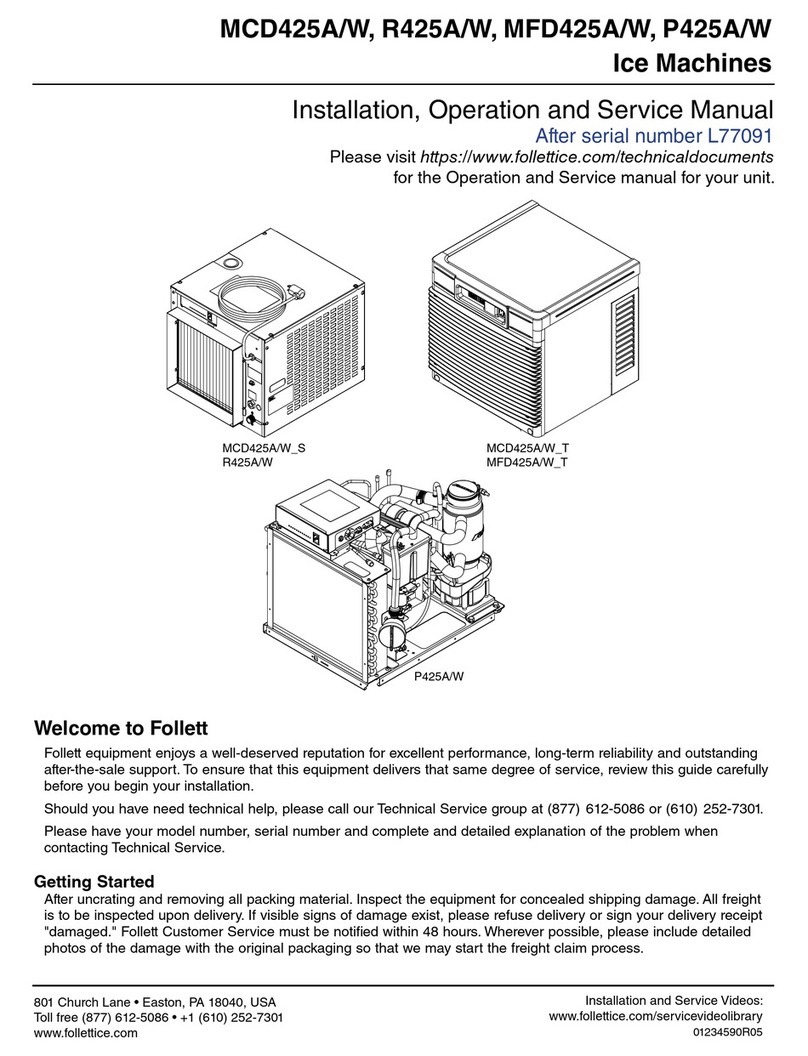
Follett
Follett L77091 Installation, operation and service manual

Hoshizaki
Hoshizaki IM-200BAA Service manual

Manitowoc
Manitowoc S0850M Service manual
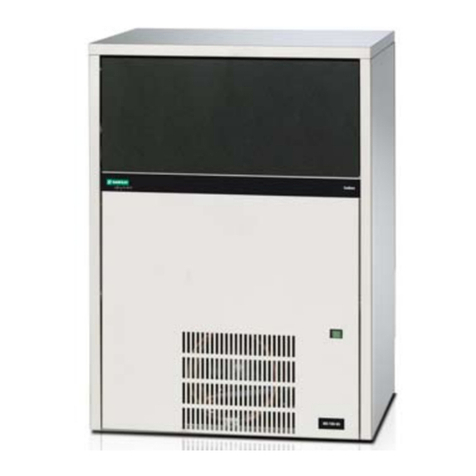
Rancilio
Rancilio ICEBOX IBS specification

Bosch Thermotechnology
Bosch Thermotechnology MUZ5EB2 instruction manual
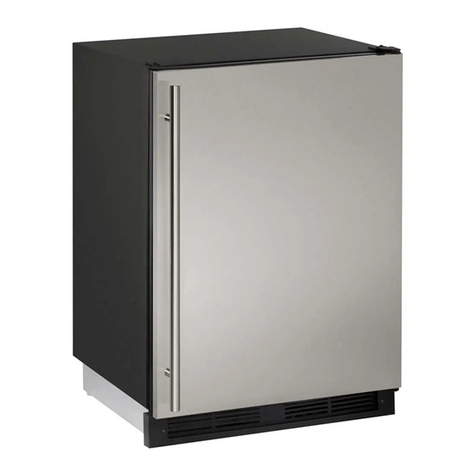
U-Line
U-Line UHRI124-SS01A User guide & service manual

Summit Classic Collection
Summit Classic Collection BIM45 owner's manual
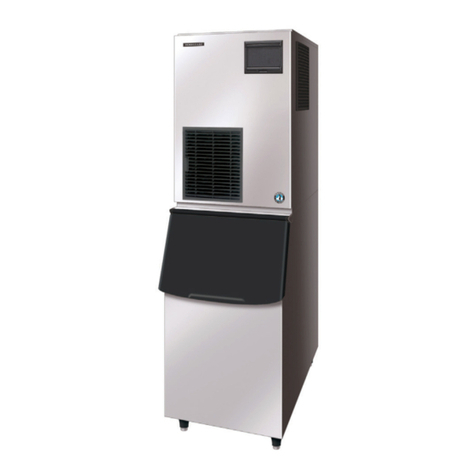
Hoshizaki
Hoshizaki FM-750AKE-N installation manual
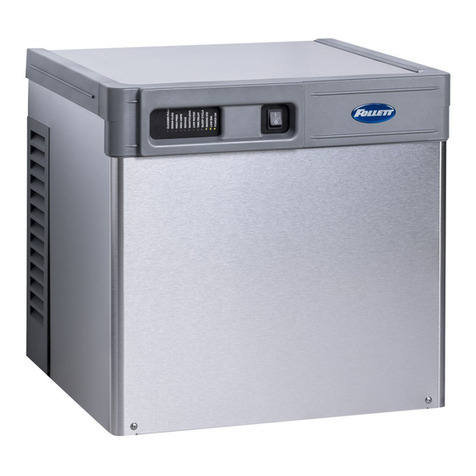
Follett
Follett Horizon Elite HCD1010RHT installation instructions
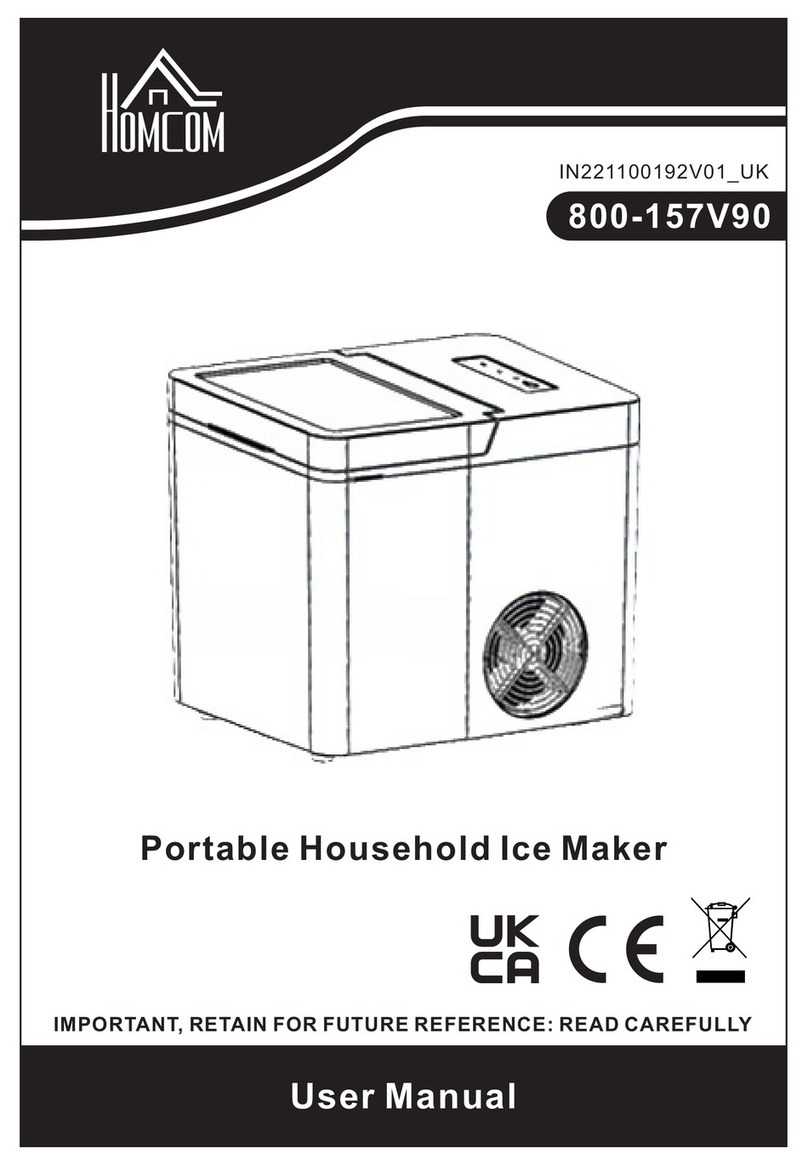
HOMCOM
HOMCOM 800-157V90 user manual
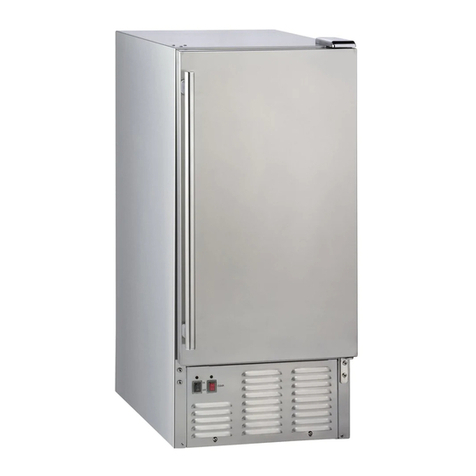
Maxx Ice
Maxx Ice MIM50-0 instruction manual
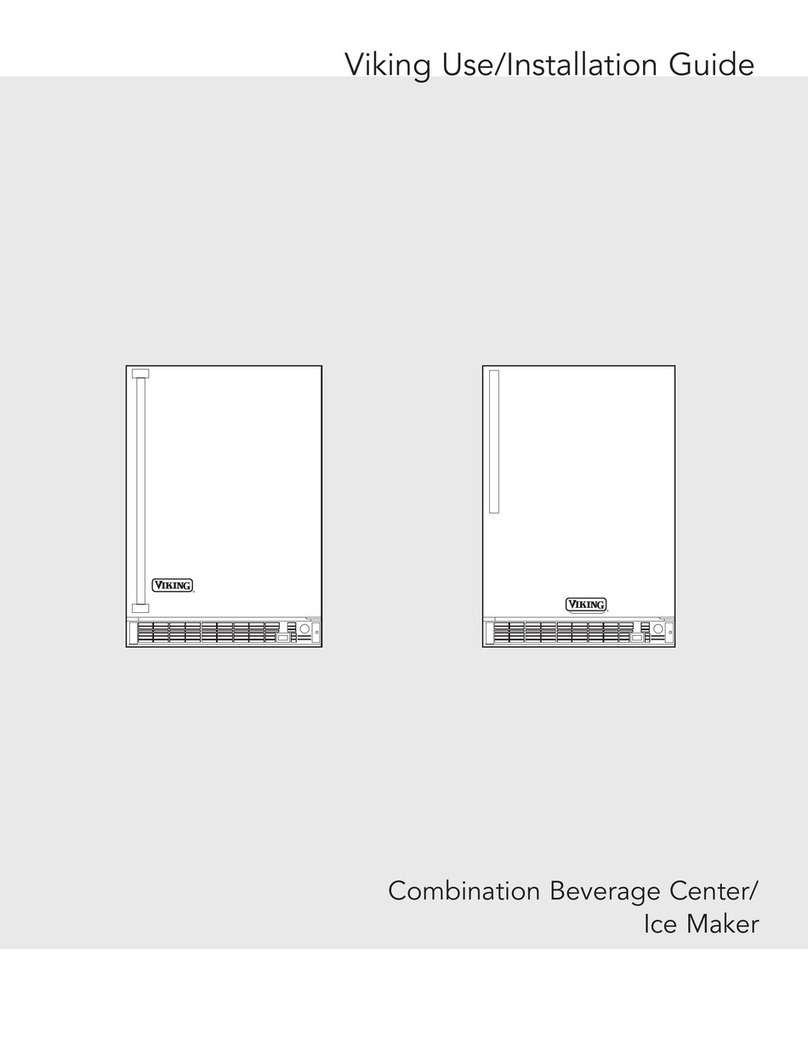
Viking
Viking Professional VUIM150D Use & installation guide



